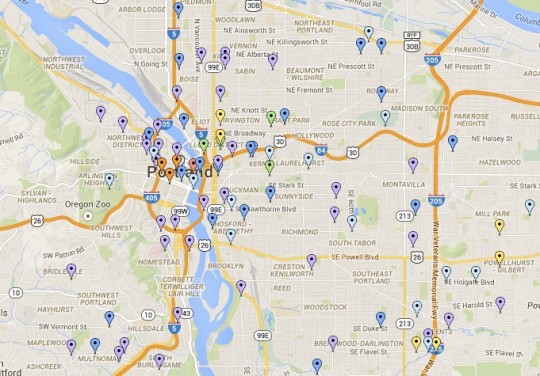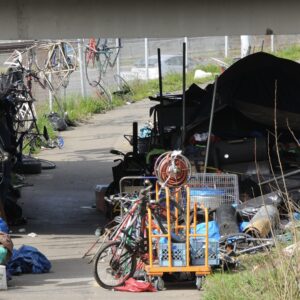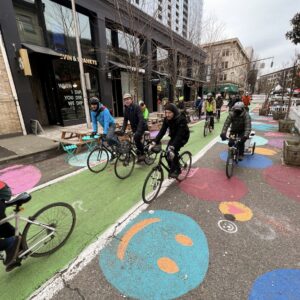As bike advocates learned long ago, you can’t start improving things until you start measuring them.
22 years after Portland’s first regular one-day bike counts, Bureau of Transportation volunteers and staffers have started tracking skateboards, too.
It’s the result of more than a year of advocacy by the NW Skate Coalition, the young organization that emerged from the 2012 fight over whether to ban skateboards from part of Portland’s West Hills.
As we wrote last year in an interview with the group’s founders, the rise of skateboard transportation has been driven in part by rapid advances in skateboard technology. And as NWSC members Cory Poole and Tessa Walker explained in a podcast episode last winter, that’s only one of the parallels between the skateboarding and bike transportation movements.
Advertisement
So what do the counts show? Unsurprisingly, the most skateboards were seen downtown, but there were also pockets of popularity in outer east, southeast and north Portland. Of all the locations observed for bike/skateboard counts, more than half saw at least one person skating.
“This data shows that despite the lack of encouragement or accommodation there [are] thousands of skateboards being used for transportation every day in Portland,” writes Poole, NWSC’s co-founder. “Just think of what the numbers would be if skaters weren’t harassed by police.”







Thanks for reading.
BikePortland has served this community with independent community journalism since 2005. We rely on subscriptions from readers like you to survive. Your financial support is vital in keeping this valuable resource alive and well.
Please subscribe today to strengthen and expand our work.
It’s really too bad they weren’t able to do counts on 82nd. There’s really a lot of skateboards on 82nd. Powell too.
Yeah, I think most of the locations here are chosen because they’re logical places to bike. (It’s a joint count, and the bike-policy dog is wagging the skate-policy tail.) Powell and 82nd are logical places to skate in part because they’re such crappy places to bike.
I would love to see the data for 82nd and Powell. Perhaps we could do some spot counts of our own. Another area of interest for me would be at or around max stations. I have observed many skateboarders using their boards to connect to public transportation.
The city does a bike count every summer where volunteers go to predetermined corners and count bikes from 4-6pm and the skateboard count was added to that this year. It was a self (by the volunteer) add-on to the bike count form so the numbers are probably not complete. I counted at 82nd & Mill and had skaters go by but the person counting 82nd & Powell may have not added skateboards to their tally or everyone skates on Mill between 4-6. Also, the bike count NEEDS volunteers in east Portland every year so if you feel your neighborhood is under-represented I encourage you to volunteer. It’s weirdly a lot of fun!
Can someone invent a skateboard with pneumatic tires, so they’re not so loud?
Adam, Belive it or not there have been pneumatic skate wheels made. they are expensive and not very effective. But luckily wheel tech has come a long way over the last ten years. Softer large diameter wheels typically used on longboards are much quieter then small hard wheels. The single largest contributor to skateboard rolling noise is the surface quality of the road or sidewalk. Smoother streets and bike lanes would benefit bicycles as well as skateboards.
78-80a durometer wheels are pretty quiet.
You can still get a little buzzing from the deck, but it is much better. The sound on mine changes depending on where my back foot is.
There is certainly a parallel to the urban bike- race bike “divide.” The tiny hard wheels are great for tricks, but not so much for going places. They make softer wheels, even for shortboards, but they’re not exactly in style.
Let me know when you find a skateboard that’s louder than a 30mph motor vehicle (even if it’s electric).
Adam, skateboard wheels come in different duro. meaning the softness. Hard wheels are loud and rough and soft wheels are smooth and quiet. They have large soft wheels available that ride quiet and run over all kinds of rocks with no problems. Its out there buddy, go check it out. Seismic wheels- Speed Vents 85mm 77duro,
I’m curious to know how much skateboarding is actually transportation. Most of the skateboarding I see being conducted in Portland is tricks and stunts.
I base this on seeing multiple people repeatedly doing jumps or whatever they are appropriately called on the same stairs, along retaining walls and benches, etc. After tiring of this activity, they depart en masse on their skateboards for presumably for another location or activity. Is this “transportation?” If I ride my mountain bike to an off-road location, I guess I consider that portion transportation and my off-road activity to be recreation.
I do sometimes see what appears to me to be transportation use (i.e. by and individual with a backpack apparently moving with a destination in mind), but that’s a minority of what I observe.
Maybe this is a distinction without a purpose, but I am curious.
you should hang out outside a high school (no sketch) and reassess.
Or Portland State University.
seriosuly
J_R, We will only get the answer to that question with more data. Keep in mind this is the first count done ANYWHERE. I am sure some riders are using their boards for recreation just as some cyclists are using their bikes to ride for recreation and exercise. Studies done by PSU Grad student Tessa Walker and the American Public Transportation Association have shown that many skateboarders are using boards for general transportation. One of the greatest challenges we face is in the perception of skateboarding. Data like this count and other studies will help shape these perceptions into reality. BTW let me know if you would like links to the studies.
Missoula Montana has been counting “other” non-motorized users for 5 years now. “Other” is typically skateboards, rollerblades, etc. So, sorry Portland, you’re not the first.
Jessi –
Yes! The “other” category is standardized in the The National Bicycle & Pedestrian Documentation Project methodology as designed by Alta and the ITE, and includes “equipment such as skateboards or rollerblades” (you can see their count forms here, for more on that projects approach to data collection http://bikepeddocumentation.org/downloads/). If you know of anybody involved with the Missoula counts I’d love a lead there – I’ll definitely follow up on their findings, and I’m curious if this is the methodology they’re using.
Skateboarders in motion move pretty differently from rollerbladers who move pretty different from folks using razor scooters or knee-walker scooters or motorized wheelchairs. Yet all these modes more vulnerable than bikes to stuff like rough pavement, loose gravel, and super-steep hills. I’m not saying that we should count the % mode share of each of these (because omg they would be teeny-tiny mode splits and likely wouldn’t tell us much), but one thing I am excited about is the route choices of skateboarders as an indicator of safer routes for these other small-wheeled modes. Skating take a lot of whole-body movement and can cause some stress on joints, so folks who are choosing to skate are generally pretty physically resilient. Some other small-wheeled modes tend carry more vulnerable users (young children, people experiencing physical disabilities, etc.). If we could identify the places people skate we might be able to start thinking about how to keep this whole fleet of smaller-wheeled modes (which fall into the “other” category in a lot of count methodologies) safer and more comfortable.
Another insight I found interesting in Walker’s research is that even more than biking, skateboarding tends to blur the recreation/transportation line. A lot of people who get around by skating reported taking little trick & stunt breaks while en route to where they’re going.
This is a good question JR, and in asking it you’ve also sort of answered it. I wrote my grad thesis on skating as a mode of transportation and a few things came clear in that research:
1. The majority of skaters get their start practicing tricks. Skating to get around is a later stage once folks have developed their skills and start having a bunch of places they need to go (a large percentage of the folks surveyed started skating for transportation during high school or college).
2. Fun and utility are always deeply linked for skaters. Folks in the study talked about stopping to skate a fun spot and practice some tricks during their commutes.
3. The kind of skating that falls more towards a sports end of the spectrum is often more visible then the skating that serves as transportation. There’s a bunch of reasons for this – folks skating a spot that’s on a high-traffic bike street will be visible to more people than that same number of skaters moving along the street as part of the flow of active mode commuters, skaters can effectively disappear by picking up their boards, etc.
Great that skaters are being counted! While i love biking, i use a skateboard for all short errands near home and work. Then last spring, i missed a bus and skated until the next one came along and made it downtown before the next bus! I realized i could do my NE – Downtown commute on a skateboard and it only took 8 minutes longer than biking!
I started coupling skating with transit and feel like skateboarding is an awesome urban mobility device by allowing one to go from a pedestrian to skating to bussing/MAXing, you have full access to the city at all different speeds.
This is an excellent first step, as all active transportation choices should be encoruaged. Skateboards as transportation would seem to me to work much better with tri-met than bikes due to their compact nature, so groups could take buses out to locations for activities.
Personally, I never got the hang of them….i got tired of falling into gutters and hitting pavement. Bike pedals have a habit of facilitating movement and safety for those with…no…coordination.
Terry – You’re right on about the space efficiency of bringing skateboard aboard transit. This is an even bigger deal in cities with subways or elevated trains – SO much simpler to carry a skateboard up and down stairs and through turnstiles.
As early as 1972 I used my skateboard as transportation, in the big city. Going anywhere at all to skate meant some distance, and the schoolyards beckoned with smooth banked transitions…..
I am glad to see that skateboarding is getting more attention.
Let’s smooth out some travel lanes, and build more parks!
Some of the close-in SE locations reported only one boarder. How long did they count? What day, and what time of day?
Carter – The city bike counts where this data came from are collected in 2-hour snapshots during morning or evening rush hour on weekdays in summer.
The City has been counting using this methodology for 14 years, so they’ve got great data on percentage change between years at various sites. They’ve also figured out multipliers for estimating how many cyclists total are traveling around based on a combination of these in-person counts, the automated counters like the one on the Hawthorne Bridge that DO count every bike all day, and census bureau surveys that ask about how people travel.
To me, the most exciting thing about having skateboard counts using this same methodology is the possibility of understanding how many folks are skating where, and why. But it will take a while to develop reliable estimates to answer those questions. Right now the awesome thing is that in alliance with the City we have an opportunity to work towards that knowledge.
The best way to support more data like this AND to find out more about the City’s count methodology is to volunteer for future counts. At the volunteer intro session you’ll get an overview of the whole process and an in-depth tour of previous years’ data (and also free pizza). Counts are finished for 2014 but you can check in here for info on the 2015 round: https://www.portlandoregon.gov/transportation/44671
Missing data: Holman/Woodlawn Pocket Park has been dominated by skaters since well before it got transformed into the rad parklette it is today
I love that park! 😀 It’s a nice cut through between my house and the bike street.
I got around with a skateboard a lot as a young kid. It was a lot of fun in a lot of places.
I eventually had to give the nod to my bike for safety reasons when I found that an immediate panick-stop was difficult to pull off with the board (figured that one out the hard way). Adding brakes, doubling the wheel base, pneumatic tires, and handlebars all made those emergencies much more manageable.
Nobody ever says “It’s like riding a skateboard . . .” because it’s just not that easy for most people to do. Ease of use will always be a problem and Skateboards will always have a built in limit for transportation use because of it.
If and when see a 70+ retired couple riding skateboards, side by side down Springwater Corridor, I’ll start to consider a skateboard as accessible transportation.
As it is, putting skateboards in the same category as walking and biking could be more damaging to the alternative transportation movement than any benefit we might hope to gain.
I remember when I attended Tessa’s thesis presentation at PSU back in 2013, I suggested working within the framework of the PBOT bike counts to get volunteers collecting skate data. A distinctive former PBOT director once told me that absence of data is a major handicap in getting the attention of transpo activists, planners and policy makers.
This is an awesome beginning!
Lol they messed up on the map.. theres this massive gap over in the colonel summers park down up by burnside and down to 28th.. i know atleast 20 people who skate in this area… and theyre like 11-20
its acualy becaus eof the bearings, not weels.. if you want quiet get some longboarding weels or oj hot juice and some new bearings